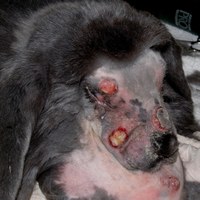Atypical myxomatosis
The term ‘atypical myxomatosis’ is confusing as it has two definitions.
- Atypical myxomatosis is also used to describe outbreaks in farmed rabbits where the rabbits do not show typical skin lesions but die from respiratory disease instead. This form of myxomatosis is spread by aerosol infection. This syndrome is characterised by a longer incubation period (1-3 weeks) and accompanied by lacrimation and mucopurulent nasal discharge (Marlier et al. 2000). As there are no skin lesions with this type of infection, the term ‘amyxomatous myxomatosis’ is sometimes used and is preferable.
- Atypical myxomatosis is mainly used to describe a mild non-lethal form of the disease. Some laboratory strains have been produced but in veterinary practice, atypical myxomatosis is usually seen in vaccinated rabbits that have a partial immunity. It presents as isolated crusting skin nodules that regress over a few weeks. The lesions can alarm owners, who worry that they may be neoplastic. The rabbits remain well. An example is shown below.

